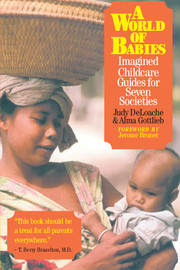Book contents
- Frontmatter
- Contents
- Foreword
- Editors’ Acknowledgments
- Note to the Reader
- CHAPTER ONE If Dr. Spock Were Burn in Bali: Raising a World of Babies
- CHAPTER TWO A Parenting Manual, with Words of Advice for Puritan Mothers
- CHAPTER THREE Luring Your Child into This Life: A Being Path for Infant Care
- CHAPTER FOUR Gift from the Gods: A Balinese Guide to Early Child Rearing
- CHAPTER FIVE Making Babies in a Turkish Village
- CHAPTER SIX Infants of the Dreaming: A Warlpiri Guide to Child Care
- CHAPTER SEVEN The View from, the Wuro: A Guide to Child Rearing for Fulani Parents
- CHAPTER EIGHT Never Leave Your Little due Alone: Raising an Ifaluk Child
- Note to Chapter One
- About the Contributors
- Authors' Acknowledgments
- Citations and Sources Cited
- Index
CHAPTER FIVE - Making Babies in a Turkish Village
Published online by Cambridge University Press: 05 September 2014
- Frontmatter
- Contents
- Foreword
- Editors’ Acknowledgments
- Note to the Reader
- CHAPTER ONE If Dr. Spock Were Burn in Bali: Raising a World of Babies
- CHAPTER TWO A Parenting Manual, with Words of Advice for Puritan Mothers
- CHAPTER THREE Luring Your Child into This Life: A Being Path for Infant Care
- CHAPTER FOUR Gift from the Gods: A Balinese Guide to Early Child Rearing
- CHAPTER FIVE Making Babies in a Turkish Village
- CHAPTER SIX Infants of the Dreaming: A Warlpiri Guide to Child Care
- CHAPTER SEVEN The View from, the Wuro: A Guide to Child Rearing for Fulani Parents
- CHAPTER EIGHT Never Leave Your Little due Alone: Raising an Ifaluk Child
- Note to Chapter One
- About the Contributors
- Authors' Acknowledgments
- Citations and Sources Cited
- Index
Summary
MUSLIMS OF VILLAGE TURKEY
Turkey is a nation of about 63 million people, half of whom live in villages similar to the one I describe in this manual. Not that long ago, a considerable majority of the nation's population lived in villages, but in the past twenty-five years, many villagers have migrated to town and city, as well as to Europe. Formerly, the divide between city and village was enormous; now the urban elite live in close proximity to swelling squatter settlements surrounding large cities. Still, few of the urban elite have ever been to a village. Although some express nostalgia for what they imagine as the simple life, most imagine villagers as dirty, dangerous, and ignorant.
The information for my “manual” comes from my anthropological fieldwork in a village in central Anatolia between 1980 and 1982. Studies of village life in Turkey are very rare, mine being one of only a handful. Although several discuss family structure, marriage, and the sexual division of labor, few describe the intimate details of procreation and child rearing.
Anatolia is the name for the major landmass of Turkey, formerly known as Asia Minor. The complexity of the land reminds me of the United States, although compressed into a much smaller area. Rather than the “Wild West,” Turkey has a “wild east” – an area of high, snow-covered mountains – that is less modernized than the rest of the country.
- Type
- Chapter
- Information
- A World of BabiesImagined Childcare Guides for Seven Societies, pp. 117 - 144Publisher: Cambridge University PressPrint publication year: 2000
- 6
- Cited by



